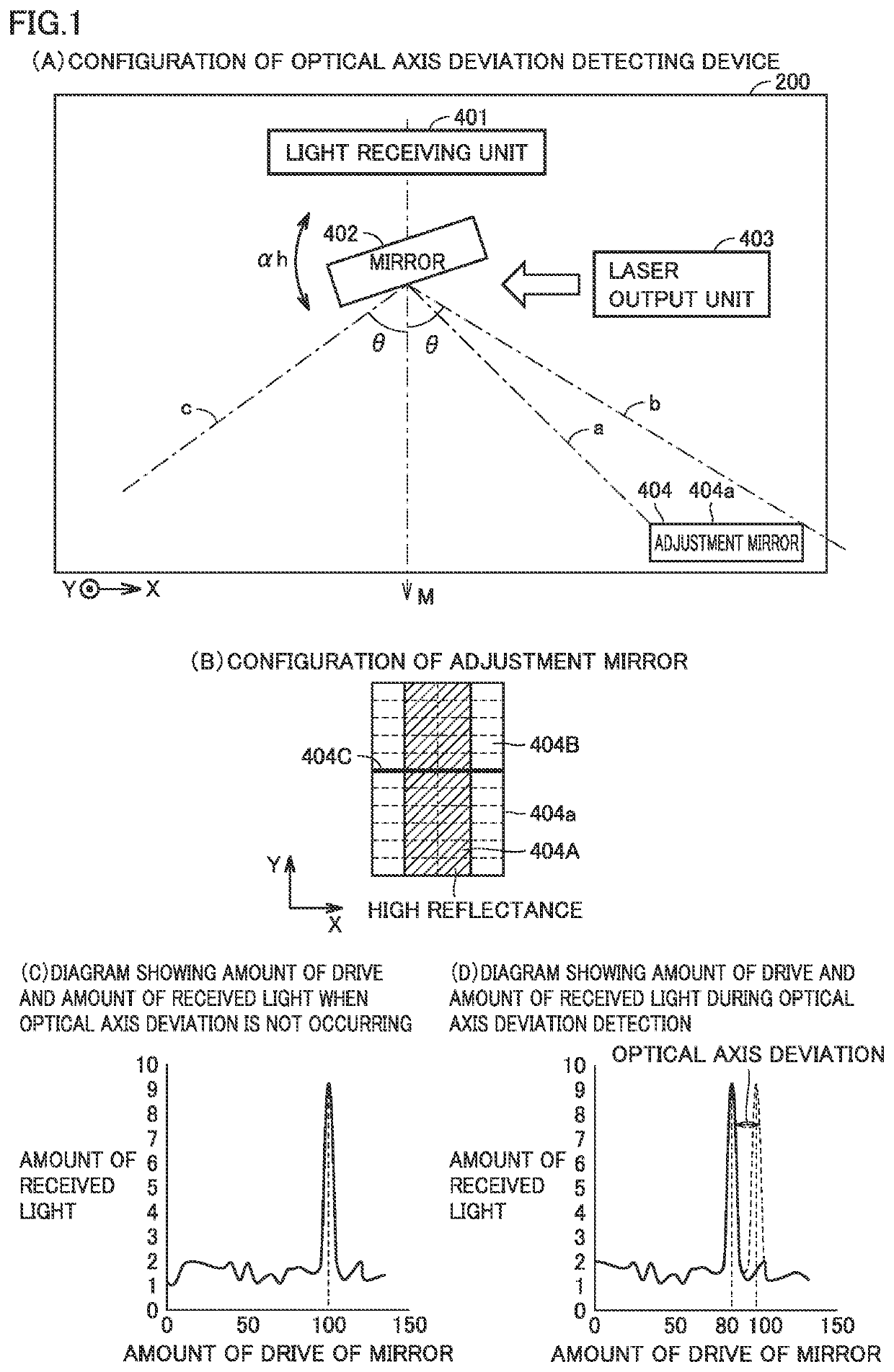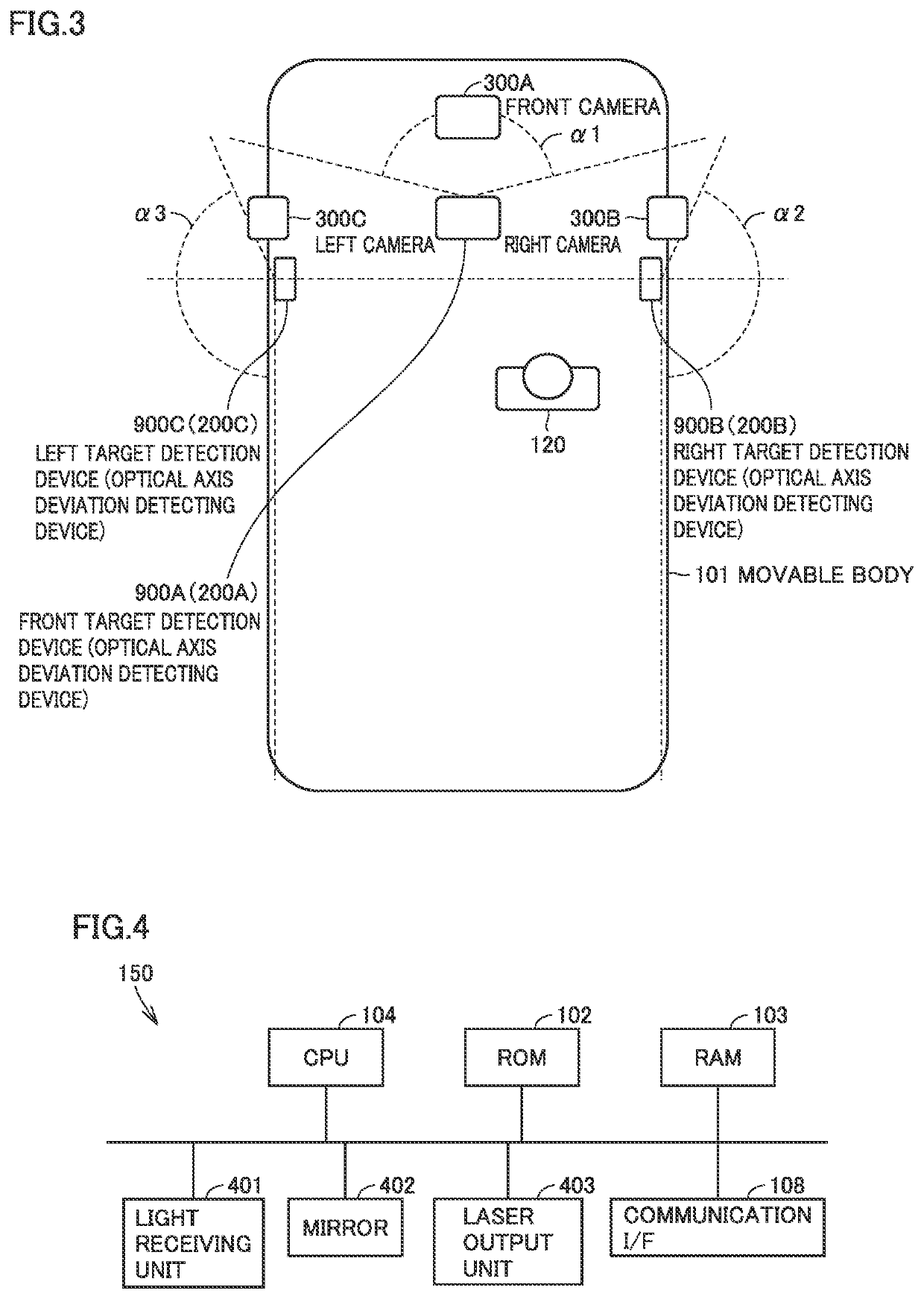Optical Axis Deviation Detecting Device, Target Detection Device, and Movable Body
- Summary
- Abstract
- Description
- Claims
- Application Information
AI Technical Summary
Benefits of technology
Problems solved by technology
Method used
Image
Examples
first embodiment
APPLICATION EXAMPLES
[0033]In self-driving of a movable body, remote sensing (remote measurement) technique for detecting the presence / absence of a target and the distance from the movable body to the target is employed in a target detection device 900. Target detection device 900 is typically a LIDAR (Light Detection and Ranging, Laser Imaging Detection and Ranging).
[0034]The resolutions in a scan range in the horizontal direction and a scan range in the vertical direction are defined by angles for each individual target detection device 900. Target detection device 900 can perform three-dimensional measurement in a wide range by detecting a target in a certain range. In target detection device 900, when an optical axis deviation of laser light occurs, an error in distance from the target to the movable body increases. It is therefore important to detect the occurring optical axis deviation. The optical axis deviation detecting device in the present embodiment detects the occurring ...
second embodiment
[0201]The foregoing first embodiment is based on the premise that when the vertical direction is fixed and mirror 402 is driven in the horizontal direction, mirror 402 is driven along the horizontal direction appropriately although an optical axis deviation in the horizontal direction may occur. Furthermore, the foregoing first embodiment is based on the premise that when the horizontal direction is fixed and mirror 402 is driven in the vertical direction, mirror 402 is driven along the vertical direction appropriately although an optical axis deviation in the vertical direction may occur. Hereinafter, such a premise is referred to as “linearity is ensured”.
[0202]In the present embodiment, an embodiment in which linearity is not ensured will be described. That is, in the present embodiment, when the vertical direction is fixed and mirror 402 is driven in the horizontal direction, it may be driven with a skew from the horizontal direction (in a direction deviating from the horizontal...
third embodiment
[0222]A third embodiment will now be described. In the second embodiment, as illustrated in FIG. 16(D), in a case where a third optical axis deviation is not occurring, the amount of drive at the peak is the amount of non-deviation drive (in the example in FIG. 16, the amount of drive corresponding to four cells). However, even in a case where a third optical axis deviation is occurring, the amount of drive at the peak is the amount of non-deviation drive in some cases.
[0223]FIG. 18(A) is a diagram showing a case where the amount of drive at the peak is the amount of non-deviation drive (the amount of drive equivalent to four cells) when a third optical axis deviation is occurring. As shown in FIG. 18(A), even in a case where a third optical axis deviation is occurring, the amount of drive at the peak is the amount of non-deviation drive (the amount of drive equivalent to four cells). Rather than the third optical axis deviation shown in FIG. 18(A), a third optical axis deviation in...
PUM
 Login to View More
Login to View More Abstract
Description
Claims
Application Information
 Login to View More
Login to View More - R&D
- Intellectual Property
- Life Sciences
- Materials
- Tech Scout
- Unparalleled Data Quality
- Higher Quality Content
- 60% Fewer Hallucinations
Browse by: Latest US Patents, China's latest patents, Technical Efficacy Thesaurus, Application Domain, Technology Topic, Popular Technical Reports.
© 2025 PatSnap. All rights reserved.Legal|Privacy policy|Modern Slavery Act Transparency Statement|Sitemap|About US| Contact US: help@patsnap.com



